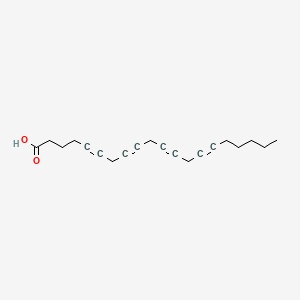| Nemeth EF and Douglas WW |
Calmodulin, phospholipase, and exocytosis. p-Bromophenacyl bromide inhibits but mepacrine stimulates secretion in rat mast cells. |
1983 |
Naunyn Schmiedebergs Arch. Pharmacol. |
pmid:6633678
|
| Diekmann JM et al. |
Angiotensin II-induced contractions of rabbit splenic capsular strips and release of prostaglandins. Use of radioimmunoassays for prostaglandins E1 and E2. |
1977 |
Naunyn Schmiedebergs Arch. Pharmacol. |
pmid:857170
|
| Suthanthiran M et al. |
Hydroxyl radical scavengers inhibit human natural killer cell activity. |
1984 Jan 19-25 |
Nature |
pmid:6694728
|
| Friedman J et al. |
Chromium chloride induces chromosomal aberrations in human lymphocytes via indirect action. |
1987 Jul-Aug |
Mutat. Res. |
pmid:3114632
|
| Emerit I et al. |
Suppression of tumor promoter phorbolmyristate acetate-induced chromosome breakage by antioxidants and inhibitors of arachidonic acid metabolism. |
1983 |
Mutat. Res. |
pmid:6877258
|
| Sobotka AK et al. |
Indomethacin, arachidonic acid metabolism and basophil histamine release. |
1979 |
Monogr Allergy |
pmid:91953
|
| Hamiduzzaman MM et al. |
beta-Aminobutyric acid-induced resistance against downy mildew in grapevine acts through the potentiation of callose formation and jasmonic acid signaling. |
2005 |
Mol. Plant Microbe Interact. |
pmid:16134894
|
| Alaoui-El-Azher M et al. |
Arachidonic acid differentially affects basal and lipopolysaccharide-induced sPLA(2)-IIA expression in alveolar macrophages through NF-kappaB and PPAR-gamma-dependent pathways. |
2002 |
Mol. Pharmacol. |
pmid:11901217
|
| Tsai SC et al. |
Effects of nitroprusside on the bradykinin responsiveness of human fibroblasts. |
1986 |
Mol. Pharmacol. |
pmid:3018483
|
| Gut J et al. |
Conversion of 5-hydroperoxyeicosatetraenoic acid into leukotriene B4 by rat hepatocytes: a novel cellular source for leukotriene B4. |
1988 |
Mol. Pharmacol. |
pmid:2843745
|
